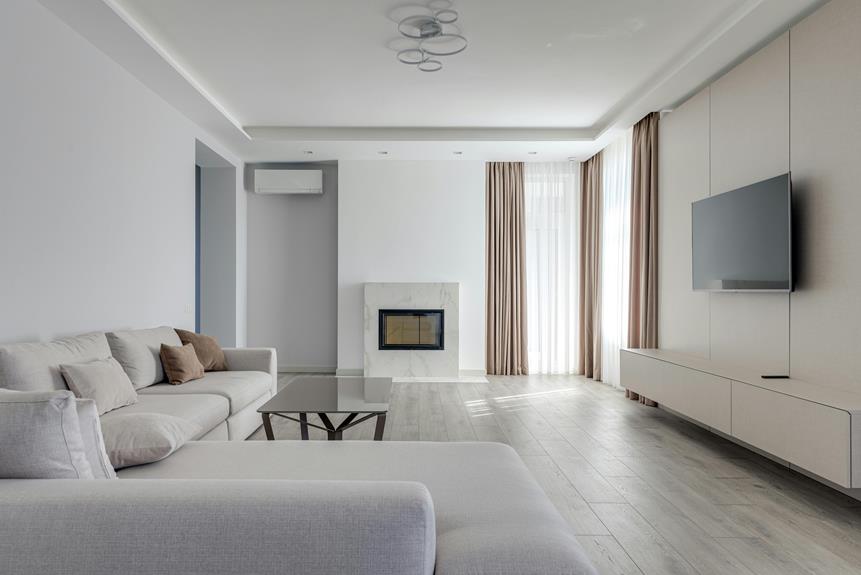If you're wondering which fabric is best for heat lamp bleaching, you'll want to consider factors like durability and color retention. Certain fabrics, such as cotton and polyester blends, are known for their effectiveness in heat lamp bleaching. Understanding the characteristics of different fabrics can help you achieve successful results in your bleaching projects.
In this guide, we'll explore the best fabrics for heat lamp bleaching, as well as provide tips for ensuring your bleaching process is a success. Whether you're a seasoned bleacher or just starting out, mastering the art of heat lamp bleaching begins with choosing the right fabric for the job.
Key Takeaways
- Fabrics with low absorbency, like polyester and nylon, are ideal for heat lamp bleaching to prevent excessive dye removal.
- Natural fibers such as cotton and linen have good heat resistance and are suitable for heat lamp bleaching.
- Fabrics with colorfast properties, like certain polyester blends, retain their color integrity during heat lamp bleaching.
- Considering the fabric's durability, heat resistance, and color retention properties helps in selecting the most suitable fabric for heat lamp bleaching.
Factors to Consider for Heat Lamp Bleaching
You should always carefully consider the type of fabric you're using for heat lamp bleaching to ensure the best results. The bleaching process is highly dependent on the fabric absorption and how the fabric reacts to the intensity of the heat lamp. Different fabrics have varying levels of absorption, which can affect how evenly the bleaching agent is distributed.
Additionally, the reaction of the fabric to the heat lamp's intensity plays a crucial role in achieving the desired bleaching effect. Some fabrics may be more sensitive to heat and could potentially be damaged if exposed to high-intensity heat lamps for extended periods.
When selecting a fabric for heat lamp bleaching, it's essential to choose one that has good absorption properties to ensure that the bleaching agent is evenly distributed. Additionally, consider the fabric's reaction to heat and opt for one that can withstand the intensity of the heat lamp without being damaged.
Understanding these factors will help you select the most suitable fabric for heat lamp bleaching and achieve optimal results.
Best Fabrics for Heat Lamp Bleaching
Consider the fabric's absorption and heat resistance when selecting the best fabric for heat lamp bleaching. The right fabric can make all the difference in achieving the desired results. When choosing a fabric for heat lamp bleaching, keep the following factors in mind:
- Absorbency: Look for fabrics with low absorbency to prevent excessive dye removal during the bleaching process. Synthetic fabrics like polyester and nylon are good choices due to their low absorbency, making them less likely to soak up excess bleach.
- Heat resistance: Opt for fabrics that can withstand the heat from the lamp without being damaged. Natural fibers such as cotton and linen have good heat resistance, making them suitable for heat lamp bleaching.
- Color retention: Consider fabrics that can maintain their color integrity even after exposure to the bleaching process. Fabrics with colorfast properties, such as certain types of polyester blends, are ideal for preserving the original color while achieving the desired bleaching effect.
- Durability: Choose fabrics that are durable and can withstand the bleaching process without losing their structural integrity. Fabrics like denim and canvas are known for their durability, making them suitable for heat lamp bleaching techniques.
When considering fabric selection for heat lamp bleaching, these factors play a crucial role in achieving optimal results. Keep in mind the specific heat lamp techniques and the desired outcome when choosing the best fabric for your bleaching project.
Durability of Fabrics in Heat Lamp Bleaching
When assessing the durability of fabrics in heat lamp bleaching, focus on the fabric's ability to withstand the bleaching process without compromising its structural integrity. Fabric durability is crucial for long-term use, and it's essential to consider how different fabrics interact with heat lamps and the maintenance required to uphold their quality. The following table presents a comparison of fabric types based on their durability and maintenance needs in heat lamp bleaching:
| Fabric Type | Durability | Maintenance Required |
|---|---|---|
| Cotton | Moderate | Regular washing, low heat drying |
| Polyester | High | Minimal maintenance, resistant to heat |
| Silk | Low | Delicate care, avoid prolonged heat exposure |
| Wool | Moderate to High | Specialized cleaning, low heat drying |
Understanding the fabric's ability to withstand the heat lamp bleaching process is essential for making informed choices. Consider the fabric's durability and the maintenance it requires to ensure its longevity.
Color Retention in Heat Lamp Bleaching
Achieve optimal color retention in heat lamp bleaching by selecting fabrics with high colorfastness. When considering color retention in heat lamp bleaching, there are several key factors to take into account:
- Color Fastness: Prioritize fabrics with high colorfastness ratings, as they're better equipped to withstand the heat exposure during the bleaching process.
- Fabric Composition: Opt for fabrics that have been specifically designed to retain color, such as those made from natural fibers like cotton or wool, or synthetic fibers like polyester or nylon. These materials are often more resistant to fading.
- Heat Exposure: Understand that excessive heat exposure can lead to color fading, so choosing fabrics that can endure such conditions is crucial for maintaining vibrant colors.
- Dyeing Process: Consider fabrics that have undergone superior dyeing processes, as this can significantly impact their ability to retain color when subjected to heat lamp bleaching.
Effectiveness of Fabrics in Heat Lamp Bleaching
To assess the effectiveness of fabrics in heat lamp bleaching, prioritize understanding the impact of fabric properties on color retention and durability. Fabric properties such as fiber type, weave, and weight play a crucial role in determining how well a fabric can withstand heat lamp exposure. Some fabrics may have better heat resistance or color-fastness properties, making them more effective for heat lamp bleaching. The table below provides a comparison of different fabric properties and their effectiveness in heat lamp bleaching.
| Fabric Properties | Impact on Heat Lamp Bleaching |
|---|---|
| Fiber Type | Natural fibers like cotton and wool may have better heat resistance compared to synthetic fibers. |
| Weave | Tight weaves can provide better protection against heat lamp exposure compared to loose weaves. |
| Weight | Heavier fabrics might offer more durability in heat lamp bleaching scenarios. |
Understanding these fabric properties will help you make informed decisions when choosing fabrics for heat lamp bleaching. By considering these factors, you can select fabrics that are best suited for your specific heat lamp bleaching requirements.
Tips for Successful Heat Lamp Bleaching
When using a heat lamp for bleaching, it's important to consider the heat resistance of the fabric you're working with. Selecting the ideal fabric for your project can make a big difference in the outcome.
Additionally, don't forget to take necessary safety precautions to protect both yourself and the fabric during the bleaching process.
Fabric Heat Resistance
Select fabrics with high heat resistance for successful heat lamp bleaching. When choosing fabrics for heat lamp bleaching, keep in mind the following tips for fabric heat resistance:
- Natural Fibers: Opt for fabrics made from natural heat resistant materials such as wool or cotton, as they've good thermal insulation properties and can withstand the heat from the lamp without getting damaged.
- Synthetic Blends: Consider fabrics that are blends of synthetic fibers like polyester and nylon, as they're known for their heat resistance and can endure the heat from the lamp during the bleaching process.
- Avoid Delicate Fabrics: Stay away from delicate fabrics like silk or chiffon, as they aren't suitable for heat lamp bleaching and may get damaged due to their low heat resistance.
- Check Fabric Labels: Always check the fabric labels for heat resistance information to ensure that the fabric can withstand the heat lamp bleaching process effectively.
Ideal Fabric Choices
Consider using natural fibers with high heat resistance for successful heat lamp bleaching, as they provide excellent thermal insulation and can withstand the heat without damage. When selecting fabrics for heat lamp bleaching, it's essential to consider fabric breathability and heat conduction properties. Natural fibers like cotton, linen, and hemp are ideal choices due to their ability to breathe, allowing air to circulate through the fabric. Additionally, these natural fibers have low heat conduction properties, meaning they are slow to heat up and provide excellent thermal insulation. This combination of breathability and low heat conduction makes them suitable for withstanding the heat of the lamp without compromising the fabric's integrity. Consider the following table for a quick comparison of fabric choices:
| Fabric | Heat Resistance | Breathability | Heat Conduction |
|---|---|---|---|
| Cotton | High | High | Low |
| Linen | High | High | Low |
| Hemp | High | High | Low |
When choosing the fabric for heat lamp bleaching, prioritize natural fibers with high heat resistance, breathability, and low heat conduction properties for optimal results.
Safety Precautions for Fabrics
To ensure success when heat lamp bleaching, you should always test a small, inconspicuous area of the fabric to assess its reaction to the heat. When undertaking heat lamp bleaching, safety measures and fabric precautions are crucial for a successful outcome.
Here are some essential tips to consider:
- Use heat-resistant fabrics to prevent damage or fire hazards.
- Ensure proper ventilation in the bleaching area to avoid inhaling harmful fumes.
- Wear protective gear such as gloves and goggles to shield yourself from chemicals and heat.
- Keep a fire extinguisher nearby in case of any unexpected accidents.
Frequently Asked Questions
Can Heat Lamp Bleaching Be Used on Delicate Fabrics Like Silk or Satin?
Yes, heat lamp bleaching can be used on delicate fabrics like silk or satin. However, it's important to consider the fabric weight and performance to ensure the best results. Always test a small area first.
Are There Any Special Precautions or Treatments Needed for Natural Fibers Like Wool or Cotton When Using a Heat Lamp for Bleaching?
When using a heat lamp for bleaching natural fibers like wool or cotton, specialized treatments are necessary. Considerations for natural fibers include monitoring the heat levels to avoid damage and using gentle bleaching agents to preserve the fabric's integrity.
How Does the Thickness or Weight of a Fabric Affect Its Performance in Heat Lamp Bleaching?
The fabric weight affects how it performs under heat lamp bleaching. Thicker fabrics may protect better against the intensity and duration of the heat lamp. Consider the fabric composition when choosing the right weight.
Are There Any Specific Fabric Blends That Are Particularly Well-Suited for Heat Lamp Bleaching?
When considering fabric blends for heat lamp bleaching, focus on those that balance heat lamp effectiveness and fabric protection. Choose blends that maintain fabric thickness and weight while minimizing potential damage. Treatments can further enhance fabric resilience.
Can Heat Lamp Bleaching Cause Any Damage to the Fabric Over Time, Such as Weakening the Fibers or Altering the Texture?
Heat lamp bleaching can damage fabric over time, weakening fibers and altering texture. To maintain fabric durability, opt for heat-resistant materials. Be mindful of texture changes from heat lamp bleaching and consider fabric blends that can withstand the process.
- Can You Get Organza Wet? - April 23, 2024
- Why Is Organza so Popular? - April 23, 2024
- What Do You Wear With Organza? - April 23, 2024






